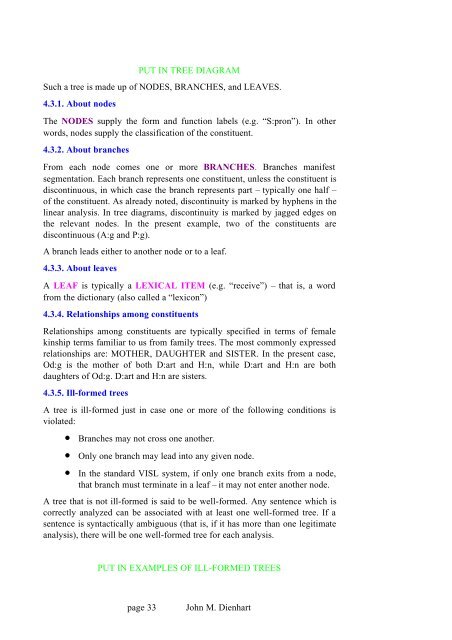Download - VISL
Download - VISL
Download - VISL
You also want an ePaper? Increase the reach of your titles
YUMPU automatically turns print PDFs into web optimized ePapers that Google loves.
PUT IN TREE DIAGRAM<br />
Such a tree is made up of NODES, BRANCHES, and LEAVES.<br />
4.3.1. About nodes<br />
The NODES supply the form and function labels (e.g. “S:pron”). In other<br />
words, nodes supply the classification of the constituent.<br />
4.3.2. About branches<br />
From each node comes one or more BRANCHES. Branches manifest<br />
segmentation. Each branch represents one constituent, unless the constituent is<br />
discontinuous, in which case the branch represents part – typically one half –<br />
of the constituent. As already noted, discontinuity is marked by hyphens in the<br />
linear analysis. In tree diagrams, discontinuity is marked by jagged edges on<br />
the relevant nodes. In the present example, two of the constituents are<br />
discontinuous (A:g and P:g).<br />
A branch leads either to another node or to a leaf.<br />
4.3.3. About leaves<br />
A LEAF is typically a LEXICAL ITEM (e.g. “receive”) – that is, a word<br />
from the dictionary (also called a “lexicon”)<br />
4.3.4. Relationships among constituents<br />
Relationships among constituents are typically specified in terms of female<br />
kinship terms familiar to us from family trees. The most commonly expressed<br />
relationships are: MOTHER, DAUGHTER and SISTER. In the present case,<br />
Od:g is the mother of both D:art and H:n, while D:art and H:n are both<br />
daughters of Od:g. D:art and H:n are sisters.<br />
4.3.5. Ill-formed trees<br />
A tree is ill-formed just in case one or more of the following conditions is<br />
violated:<br />
• Branches may not cross one another.<br />
• Only one branch may lead into any given node.<br />
• In the standard <strong>VISL</strong> system, if only one branch exits from a node,<br />
that branch must terminate in a leaf – it may not enter another node.<br />
A tree that is not ill-formed is said to be well-formed. Any sentence which is<br />
correctly analyzed can be associated with at least one well-formed tree. If a<br />
sentence is syntactically ambiguous (that is, if it has more than one legitimate<br />
analysis), there will be one well-formed tree for each analysis.<br />
PUT IN EXAMPLES OF ILL-FORMED TREES<br />
page 33<br />
John M. Dienhart
















